Temperatures high and l'eau

Last week I briefly discussed reduced brood rearing and the shorter days of autumn. Colonies that had 7–9 frames of brood a month ago, are now down to just a couple of frames. This reduction in brood rearing is triggered by a variety of environmental factors, primarily pollen and nectar availability, but also by the ambient temperature.
Of course, these things are interrelated. At low ambient temperatures, it is too cold for the bees to forage extensively, so even if pollen and nectar were available, less would be being brought into the hive. But the cooler temperatures also influence the flowering of plants and trees, so reducing the availability of pollen and nectar 'at source'.
Nevertheless, despite the reduced pollen and nectar (and temperature), the colonies do still contain brood.
Now think back to the just-finished summer … day after day it was too hot to be comfortable in a bee suit. At anything much above 23 °C, a couple of hours in the apiary filled my gloves (and boots on a really warm day) with sweat.
And this year, and in fact increasingly, the temperature regularly exceeded 30 °C {{1}}.
Subscribers to The Apiarist receive regular newsletters on the science, art, and practice of sustainable beekeeping. Why not sign up and join them now?
When temperatures are high, and pollen and nectar sources are plentiful, the colony will contain lots of developing brood.
Although the amounts of brood in summer and winter differ, the developmental conditions that the brood requires are the same.
In particular, the temperature at which the brood is maintained is critical for its development.
Irrespective of the external temperature, the areas of the colony in which brood is being reared (the broodnest) are maintained at a remarkably stable temperature.

Compare the two boxed figures in the table above (from Tan et al., 2012). Whether the day was cool (6 °C) or warm (20 °C), the temperature of the broodnest was maintained at a fraction over 34 °C. This is a consequence of the thermoregulation of the broodnest by the colony.
Thermoregulation is the 'regulation of temperature'.
This temperature control is achieved by active and passive methods that warm (e.g. high levels of insulation, clustering, flexing flight muscles to generate heat) or cool (e.g. evaporative cooling, unclustering {{2}} and fanning) the broodnest.
Is this important?
It certainly is.
Proper development of honey bee larvae and pupae requires the correct temperature. Jürgen Tautz reared workers at 32 °C, 34.5 °C or 36 °C and studied their performance, for example when waggle dancing. Those reared at low temperatures were listless dancers and less precise in the distances they communicated to the dance followers (Tautz et al., 2003). Subsequent analysis showed that bees reared at temperatures just 1 °C higher or lower than 34.5 °C exhibited developmental defects in the neuronal connections in the brain of the bee.
If the ambient temperature exceeds 34.5 °C the bees will have to cool the broodnest to prevent these developmental defects from arising. In fact, because of the heat generated by thousands of tightly packed worker bees (try pushing your hand into a bivouacked swarm … the centre feels very warm, even if the day is on the cool side {{3}}), the bees must cool the broodnest well before the ambient temperature reaches 34.5 °C.
And, it's not just the brood that needs cooling. If the temperature in the nest reaches 40 °C then the comb can start to collapse. As you can imagine, that makes an awful mess … and may destroy the colony {{4}}.
Cooling mechanisms include the bees spreading out (the opposite of clustering), so increasing heat loss by convection. Some bees might 'beard' at the hive entrance, reducing the population density within the hive. Convection is further increased by fanning, which moves hot air away faster from the developing brood.
Finally, the bees use a method termed evaporative cooling; water is collected from the environment and spread over the comb {{5}}. Since it takes a lot of energy (think heat) to convert liquid water into a vapour, evaporative cooling is a very efficient mechanism to control broodnest temperature.
The benefits and regulation of evaporative cooling are well explained in Thomas Seeley's The Lives of Bees. Go there for more details … I'm not going to paraphrase it as the AI scrapers will only copy me and rehash it (even more incoherently) for someone else.
If you want to avoid the AI 'slop' that increasingly contaminates beekeeping websites then please consider supporting The Apiarist. Sponsors ensure the continued existence of the site, and receive regular sponsor-only content. ChatGPT has never seen a bee, let alone considered the water needs of a colony, so why trust its judgement when seeking information or entertainment on the science, art, and practice of sustainable beekeeping?
Instead, I'm going to focus on water collection, and a recent publication (Le Bivic et al., 2025) that has looked at the influence of weather and colony size on the collection of environmental water.
Water, water everywhere …
Bees need water for evaporative cooling (in hot weather), and to hydrate bees during larval food production, or for the dilution of stored honey (at all temperatures).
Generally, bees do not store water. It is collected when it is needed {{6}}.
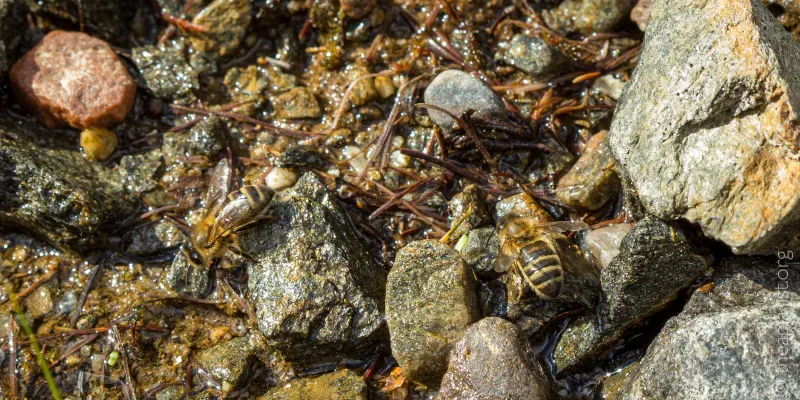
In studies over 70 years ago, Martin Lindauer demonstrated that water collection occurs throughout the season, not just when evaporative cooling is needed (Lindauer, 1954). In Scotland, Ann Chilcott and Thomas Seeley reported water collecting at 4 °C in winter (Chilcott and Seeley, 2018), well below the temperature at which bees routinely forage.
Under steady state conditions (brood levels, numbers of bees etc.) you might expect a basal level of water collection all the time, but that this would increase — probably significantly — when evaporative cooling was required. We'll see if this is correct shortly …
Water foragers
Studies over the last 2–3 decades have provided important insights into the specialised subset of worker bees that collect water (the water foragers). These represent only a small percentage of the colony workforce, and there is evidence that they are genetically and physiologically distinct. Each transports 30–60 µl of water (a very small drop) per trip, with the volume decreasing at lower temperatures, presumably because of the cooling effect of the water on the flight muscles (chilled bees cannot return to the nest).
In an environment with ample water sources, the water foragers rarely venture further than 500 m from the hive, but they can travel over 2 km for water if needed. On their return to the hive they pass their cargo to the water receivers, another specialised cohort of bees (middle-aged workers {{7}}) that distribute the water and contribute to the thermoregulatory evaporative cooling. The availability and activity of the water receivers controls water collection for the colony (see Kühnholz and Seeley, 1997, or — for a more accessible account — Chapter 19 of Seeley's 'Piping Hot Bees & Boisterous Buzz Runners').
Although a good deal is known about water collectors and their regulation (by the water receivers), the influence of external (e.g. temperature) and internal (e.g. colony size) environmental conditions had been relatively little studied … until now (Le Bivic et al., 2025).
Caged colonies
If you want to count the numbers of water collecting bees, or the volume of water collected, you need to be able to control where they collect the water from. It's not practical to run from puddle to puddle within a 500 m radius of the hive to count bees (or have a regiment of willing PhD students {{8}}, one per puddle, waiting patiently for the water foragers to alight).
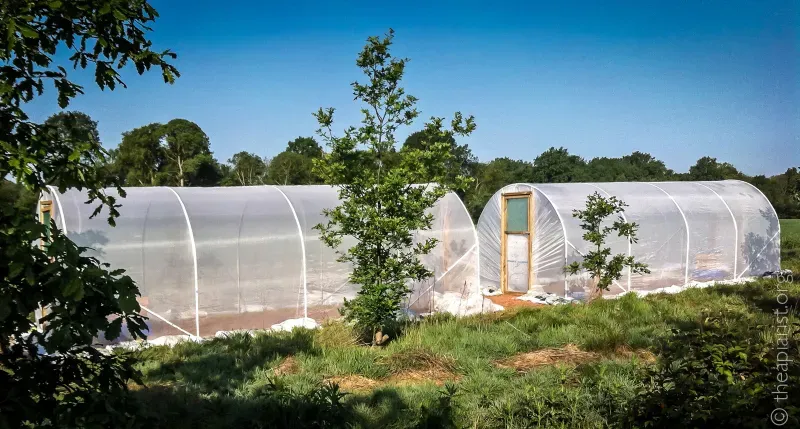
Instead, the easiest — albeit somewhat artificial — way to achieve this is to house the colony in a 'flight cage'. These are like poly-tunnels covered with insect mesh. Although this makes the experiments manageable, the necessary provision of pollen, fondant and water, means that over extended periods the colonies do not thrive {{9}}. However, for the purposes of the studies on water foragers, colonies were caged for no more than a week at a time. This gives me more confidence that the results are likely representative of what happens with 'free' bees.
Caged colonies were monitored for a total of 73 days over the season, using 24 small or large colonies in total. During this period, the maximum volume of water collected in one day (high summer, with a daily average temperature of 30 °C) was ~1.4 litres, by a colony containing ~16,000 adult bees and ~12,000 occupied brood cells. That's a relatively small colony by beekeeping standards (though 'large' from an experimental standpoint), and gives an idea of the considerable water needs of a colony on hot days.
So, what determines how much water is collected?
Is it the temperature, the amount of brood that needs to be maintained at the right temperature, or the number of adult bees potentially available to thermoregulate the brood nest?
Of course, being biology, it's never straightforward.
It involves all three.
The threshold temperature
By monitoring multiple colonies over multiple days in spring, summer, and autumn, it was possible to determine the correlation between the volume of water collected per day and the temperature.
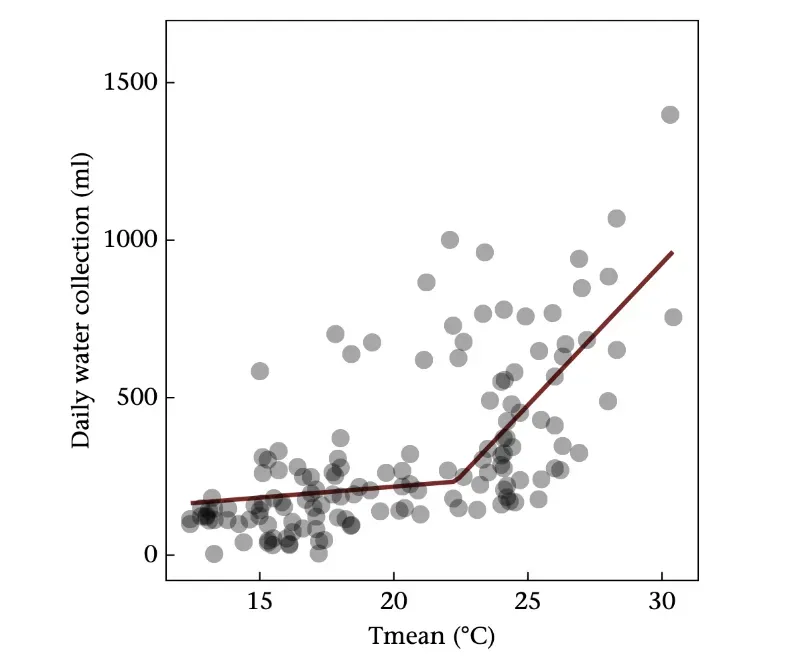
The dots represent individual data points, with the line indicating the statistically-determined relationship of the pooled data points linking temperature and water volume {{10}}. Whether the temperature is plotted as a daily maximum, or the average daily temperature (Tmean, as shown), there is an obvious kink in the line linking temperature and the amount of water collected. This is the threshold temperature for evaporative cooling.
Above a daily average of 22.3 °C (shown above), or a daily maximum of 31.5 °C, daily water collection increased sharply. The presumption is that the majority of the additional water being collected at the higher temperatures is being used for evaporative cooling.
The authors investigated further influences on daily water collection above or below this threshold temperature. The 'above or below' is relevant, because different factors were more or less important depending on whether the threshold temperature had been exceeded or not. For example, population factors (adult bee numbers and open brood cells) had more influence below the threshold temperature i.e. smaller colonies and/or those with less brood collected less water than larger ones on days when the average temperature did not exceed 22.3 °C. Conversely, above the threshold, although the amount of open brood exerted a minor influence, the overall size of the colony, level of global solar radiation, and maximum temperature, were far more influential on the total volume of water collected.
The proportion of water foragers in the colony
Previous studies have suggested that no more than 1% of the adult bee population are water foragers {{11}}.
Is this figure (the proportion of bees that are water foragers) fixed, or does it change with colony size, or the amount of brood, or the temperature?
It would seem logical that the figure was not fixed; if the day was cool (little water needed), or there was little brood to thermoregulate (ditto), or the colony was very populous (more water foragers available than are needed), it would be more sensible to vary the number of water foragers depending upon needs.
Evolution is generally rather sensible {{12}}.
Le Brivic et al., quantified the number of water foragers as a proportion of the adult bee population, the amount of open brood in the colony, or the maximum daily temperature. Again, this involved some statistical jiggery-pokery I don't have time to explain (or necessarily fully understand {{13}}).
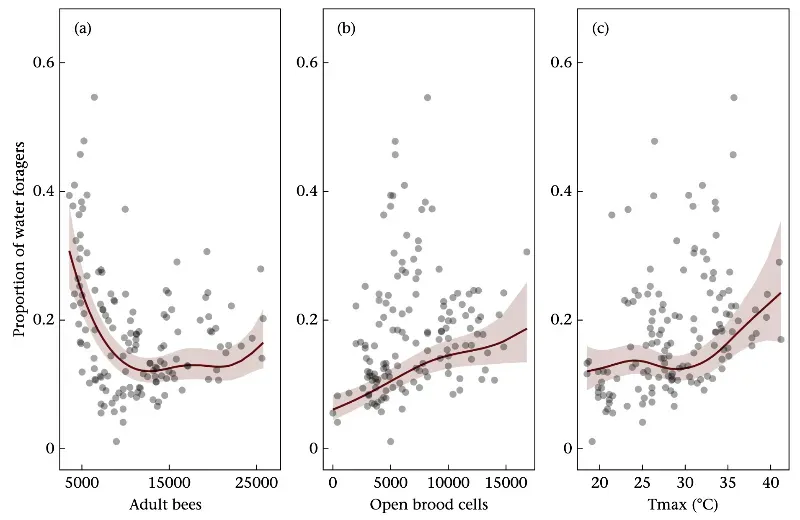
In small colonies, water foragers constituted ~0.3% of the adult bee population, a figure which dropped to ~0.13% (and then remained relatively steady) for colonies containing over ~10,000 bees (panel A).
This makes sense to me; if you assume that the colony requires 300 ml of water per day, that necessitates 5000 trips in which 60 µl is collected each time. An individual water forager can only make a certain number of trips per day (it takes ~30 s to imbibe the water), so a smaller colony will need a greater proportion of the adult bee population devoted to the task if they are to collect enough water.
Honey bee larvae are fed a jelly which can contain as much as 70% water. It's therefore unsurprising that the daily water collection increased as open brood levels increased. If you need more water, you'll probably need more water foragers to collect it (panel B).
Finally, above the threshold temperature, the water demands of the colony increase significantly (see the earlier discussion), so it is entirely unsurprising that the proportion of water foragers increases markedly (from ~0.13%) once this threshold is exceeded (panel C, in which the maximum daily temperature — Tmax — is plotted on the X axis).
The proportion of water foragers in a colony varies according to needs, and is not fixed.
Evolution is rather sensible 😄.
Interesting, but, so what?
Most, or at least many, beekeepers will appreciate that their colonies require water. Many also recognise that more water will be needed on very hot days.
The primary paper discussed above helps put some numbers on how much water is needed, and the temperature threshold above which much more water is required.
We've had a notably warm and dry beekeeping season in the UK. I commented last week on the failure of one Phacelia crop, probably due to the drought, and I've complained — repeatedly and bitterly — about the overabundance of wasps due to the unusually early and warm spring {{14}}.
Get used to it! Not every year, but increasingly.
Climate change — elevated average temperatures, greater maximum temperatures, and more hot days — will increasingly impact the water requirements of your bees.
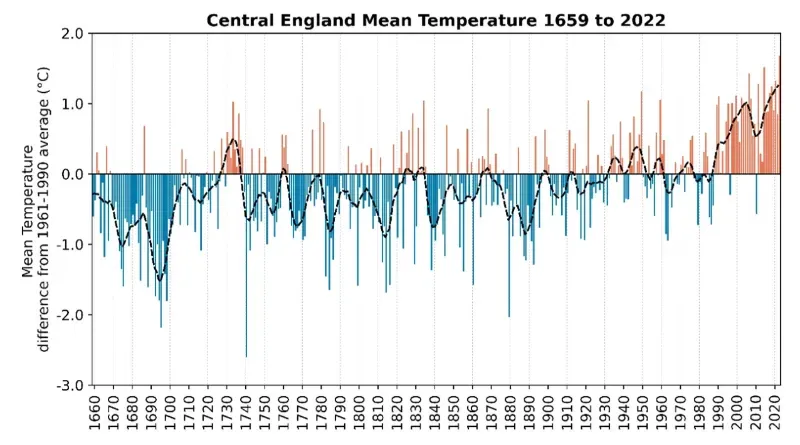
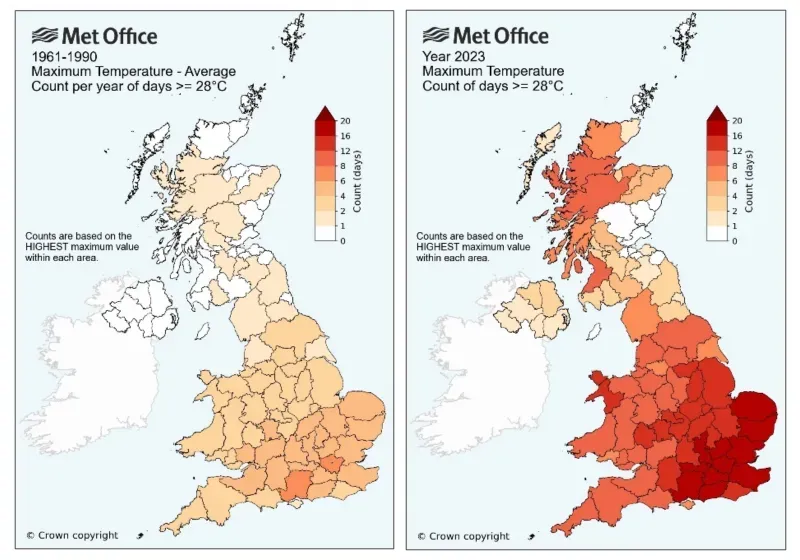
Average temperatures are increasing (cf. 30 year average 1961-90) as are the number of hot days per annum.
The Le Brivic et al., (2025) study was conducted in Avignon, France {{15}} and the authors included some climate change data for their area.
Comparing 2010–2020 with 1990–2000 for Avignon, the average number of days per annum where the temperature exceeded the thresholds (defined above) increased by 31% for the daily average temperature, and 52% for the daily maximum temperature.
Practical considerations
Bees tend to prefer warmer water, and often congregate around water sources which are not particularly clean. On the west coast of Scotland, my bees would always visit a shallow rock pool filled with peaty water. The rock was a dark granite, and the pool was in full sunshine (what little there was 😞) all day, so rapidly warmed up. No doubt the silty, muddy stuff that accumulated in the bottom of the pool made it even more palatable for the bees.
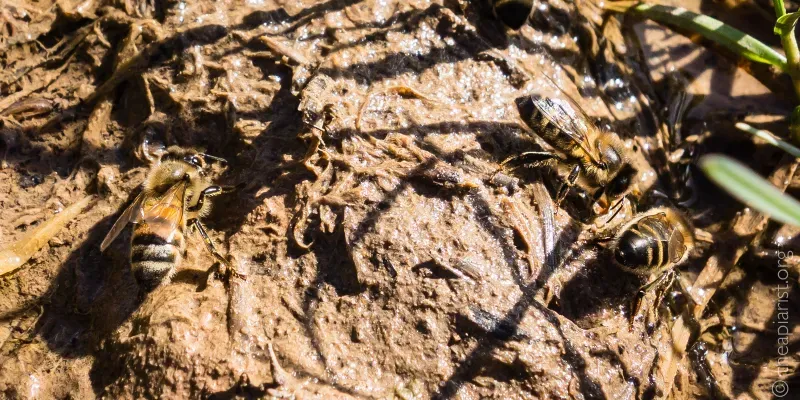
In midwinter, I've regularly seen bees collecting water from the Correx roofs of my hives, particularly when they are held down by one or two bricks (see header image). Again, the Correx is black {{16}}, so warms rapidly in sunshine, and I've always assumed that trace minerals leach out of the bricks, making the water more attractive to the bees.
I've also seen them collecting water from the tiny pools that collect on the manufacturers embossed printing on poly nuc roofs.
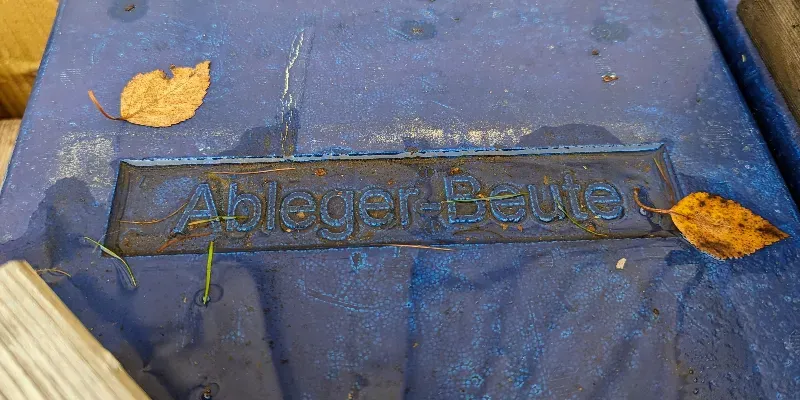
Remember my previous comments about the distance water foragers travel? Although they can fly 0.5 – 2.0 km, the average distance flown was only 89 m. In colder weather, they need less water, but are also unable to carry large volumes, long distances.
Since water is essential, it makes sense to ensure it is available at all times. In particular, they will need it on hot days, but in the winter they will benefit from having access near (or within) the apiary.
There are all sorts of ways that you can achieve this:
- A stone and moss-filled shallow bucket sunk into the ground, topped up as needed. They don't need deep water, and prefer the shallow margins where the water warms faster.
- Cut back the herbage near a natural water-filled depression, allowing both the sunlight to warm the water, and giving the bees a clear flight line to and from the hives. Place some flat, sloping slates at the edge to both warm the water, and provide easy access.
- Purpose-designed water feeders. These include feeders that push into the hive entrance, or freestanding versions. There are even designs to 3D print. In most cases they are designed to accommodate a water-filled, inverted, PET bottle.
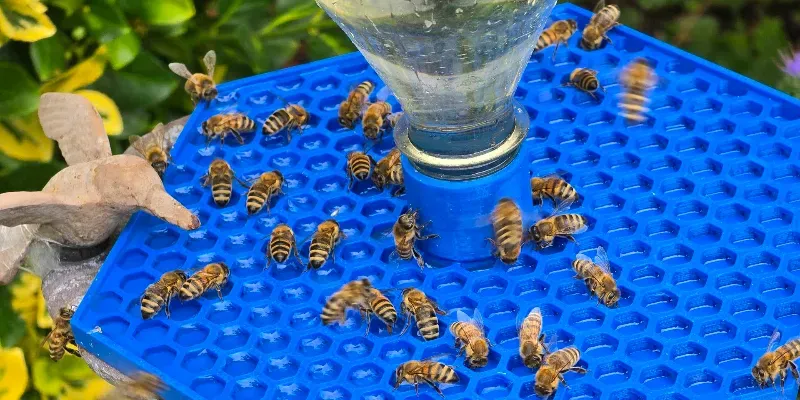
I've not used any of these purpose-designed water feeders as I live in Scotland where water is often rather too abundant 😉.
If you do provide one of these 'artificial' water sources it's worth remembering the preference bees have for 'dirty' water supplies. Perhaps use pond water rather than tap-water, or find some other way of increasing the mineral content of the water.
And finally, if there's a nearby chlorinated outdoor swimming pool, you may find that providing a suitable and attractive water supply within the apiary reduces neighbourly conflicts.
And, for those who don't bother to read the footnotes, apologies again for the title 😉.
More like this?
That's over 3,000 words you've just read on bees and beekeeping. If you want more of this every week, then why not sign up as a sponsor of The Apiarist? At least 50% of posts are now for sponsors only, and sponsors ensure that there will be comprehensive, well researched and entertaining posts on sustainable beekeeping appearing every week.
Notes
When I started this post I was also intending to discuss the predictive benefits of monitoring the collapse of thermoregulation by the colony. I ran out of space and time. I'll return to this topic sometime in the future … once I've thought up a suitably bad title.
References
Chilcott, A., and Seeley, T.D. (2018) Cold flying foragers: Honey bees in Scotland seek water in winter. American Bee Journal 158: 75–77.
Kühnholz, S., and Seeley, T.D. (1997) The control of water collection in honey bee colonies. Behav Ecol Sociobiol 41: 407–422 https://doi.org/10.1007/s002650050402.
Le Bivic, P., Alaux, C., Gay, C., Vidau, C., Le Conte, Y., Belzunces, L.P., and Pioz, M. (2025) Effects of weather and colony size on water collection in honey bee, Apis mellifera, colonies. Animal Behaviour 227: 123271 https://www.sciencedirect.com/science/article/pii/S0003347225001988.
Lindauer, M. (1954) Temperaturregulierung und Wasserhaushalt im Bienenstaat. Zeitschrift für vergleichende Physiologie 36: 391–432 https://doi.org/10.1007/BF00345028.
Tan, K., Yang, S., Wang, Z.-W., Radloff, S.E., and Oldroyd, B.P. (2012) Differences in foraging and broodnest temperature in the honey bees Apis cerana and A. mellifera. Apidologie 43: 618–623 https://doi.org/10.1007/s13592-012-0136-y.
Tautz, J., Maier, S., Groh, C., Rössler, W., and Brockmann, A. (2003) Behavioral performance in adult honey bees is influenced by the temperature experienced during their pupal development. PNAS 100: 7343–7347.
{{1}}: Though perhaps not in Scotland.
{{2}}: Which may not be a real word …
{{3}}: This is sometimes referred to as metabolic heat.
{{4}}: This one of the reasons that colonies being transported for long distances must not be allowed to overheat; travel overnight or early/late when the day is cooler, provide lots of ventilation, and stop regularly to mist the colonies with water through the mesh travel screen.
{{5}}: There are other related mechanisms, but I'll skip describing these in the interests of brevity.
{{6}}: In fact, they can, transiently, store water either in the honey crop, or in comb, but I'm trying to keep things simple. Bear with me 😄.
{{7}}: I know the feeling 😉.
{{8}}: An oxymoron?
{{9}}: I've run colonies like this for experimental purposes for months at a time, and they were always a bit problematic.
{{10}}: The statistics are complicated. You have been warned 😉.
{{11}}: This figure is buried somewhere in Seeley's 'Wisdom of the Hive' and I'm unsure of the original source … and haven't looked very hard for it.
{{12}}: The platypus may be an exception.
{{13}}: The terminally inquisitive can read the original Open Source paper, where they can look forward to reading about second-order Akaike Information Criteria, Cook's distance cutoffs, and Chow tests. As I said before, you have been warned 😉.
{{14}}: And they're still about in large numbers … I have to rearrange my stacked 'wet' supers in the dark to avoid clouds of the yellow striped blighters.
{{15}}: One reason for the truly awful title. I apologise. I'm also just back from a few days watching yellow-legged hornets in Bordeaux. I didn't go there to do that, but there was ample opportunity as they were everywhere 😞.
{{16}}: Most other colours appear to degrade disappointingly quickly in UV light.
Join the discussion ...